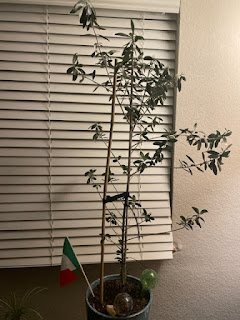Passiflora caerulea - a popular climber, known as Passion Flower.
This is what each individual flower looks like - exotic, aren't they?
And large, too - the size of the palm of your hand.
Why is it called "passion flower?" I hear you ask. Well, it's based on religion, the Passion of Christ, which was nothing to do with having a good time, but was more to do with his suffering, as it's a corruption of passus sum; "to suffer, bear, endure"
So, like pretty much everything based on religion, it starts off with a mis-quote, and gets worse from here on in.
According to the internet:
"The five petals and five sepals are the ten disciples less Judas & Peter. "
Hmmm. So alleged "history" has actually been twisted, to fit the flower.
I mean, if it only had four petals and four sepals, no doubt it would be "the flower represents the ten disciples (they mean, the 12 disciples, of course) less Judas, Peter, James and another one."
To continue: "The corona filaments are the crown of thorns. The five stamen with anthers match the five sacred wounds & the three stigma the nails. " I can't comment on the sacred wounds, I don't know anything about them: but as for the nails, up until the Middle Ages - ie closer in time to when these events are reputed to have happened - Christ on the cross was always depicted with four nails. It wasn't until the C13th that Western art started painting the figure with the feet overlapping, thus only needing one nail instead of two. So I don't think we can give that resemblance much credence.
Finally, and hilariously, one internet source continues: "This symbolism is not universal however, in Japan it is sometimes known as ‘The Clock-faced Plant’ and apparently has recently been adopted as as symbol for homosexual Japanese youths." Hilarious! (because of Christianity's well documented lack of tolerance for anything other than white middle-class heterosexuality.)
Right! Let's forget about all that rubbish, accept that the common name is Passion Flower, and move on.
What is it, and why do we love it? It's a climber, it's fully hardy, it can be cut down to the ground every year, or allowed to romp away and take over: in mild winters it stays evergreen, and the flowers are FABULOUS!!
All it needs is a few wires to get it started, and will climb as high as you wish.
Here's one I grew for a Client: I know it looks a bit like a football goal, but it's actually an old net-covered vegetable frame, stood up on end.
One Passion Flower planted on each side, and by the end of summer, it covers the entire frame, so all you can see are leaves, and flowers.
And it makes a shady bower, in which to sit.
Here's one in my own garden: for various reasons, I had to cut it right back to nothing in early summer, leaving just this one twisty main stem: this was taken in June 2021.
And it looks as though it's dead.
But it's not!
Within days, it was putting out new leaves, and shoots, and by the end of summer, it had covered the fence as usual, flowering like a mad thing.
Having cut it back so hard in June, I didn't cut it back again in autumn, I just left it:
And here it is in February 2022, after a very mild winter, and it's still lush and evergreen, as you can see.
This gives you an idea of how sturdy and resilient this plant is, despite the exotic-looking flowers.
I should also say that this one, my one, is growing on a north-facing fence, and it has a tiny patch of really poor soil at the base, with competition from my neighbour's thick hedge, on the other side of the fence. So it's in a pretty hostile situation, and yet it comes up flowering, every year without fail.
There is another twist in the tail (tale?) of this climber: once the flowers are pollinated, a few of them will produce:
Seed pods!
Aren't they glorious!
Aren't they huge!
They start off bright green, like this, and over a few weeks, they turn bright orange, which really brings another season of interest to this climber.
No, they're not edible, despite what you might read on the internet: inside is a fluffy mass of loose pulp, containing a large number of seeds, most of which will happily germinate.
In fact, if you are new to gardening, or new to propagation in particular, then start with Passion Flower, because they are hearteningly easy to grow.
All you have to do (don't you love things which start off "all you have to do" ??!!) is wait until the seed pods turn orange, then pick a nice big one, and bring it indoors. Break it open, and by that I mean "insert thumbnails and gently pull apart" because they are soft and squishy: scoop out the pulp and put it in a sieve. Hold it under a slowly running tap while you mush the seeds around, to wash off all the sticky pulp.
Once they are clean ("ish"), put them on a sheet of kitchen towel, and gently rub them until they are dry, and all the pulp is off. Then put some of them into a pot with some soil, leave it outside somewhere, keep it moist-ish, and either very soon, or next spring (depending on weather etc) you will find a lot of skinny little shoots springing up.
Success!
You have propagated your Passion Flower!
Pot them up, grow them on a bit, then plant them out and lo! and behold, you will have your very own Passion Flower, free of charge, and next year, it will be ramping away up your house/fence/shed/garage, and you will have your own beautiful, exotic flowers to enjoy.
Did you enjoy this article? Did you find it useful? Would you like me to answer your own, personal, gardening question? Become a Patron - just click here - and support me! Or use the Donate button for a one-off donation. If just 10% of my visitors gave me a pound a month, I'd be able to spend a lot more time answering all the questions!!

































